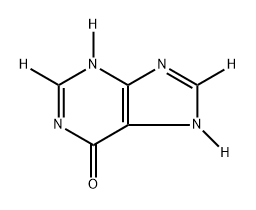Hypoxanthine-d4 is intended for use as an internal standard for the quantification of hypoxanthine by GC- or LC-MS. Hypoxanthine is an endogenous purine derivative and the major purine involved in the purine salvage pathway in the brain.1 Intrastriatal administration of hypoxanthine (10 μM) increases mitochondrial complex II, also known as succinate dehydrogenase, activity and decreases cytochrome c oxidase activity, resulting in neuroenergetic impairment, ATP depletion, and cellular apoptosis in rats. Hypoxanthine also induces hyperuricemia in mice.2 Spinal fluid levels of hypoxanthine are increased in patients with Lesh-Nyhan syndrome, an inborn error of metabolism characterized by cognitive deficits, motor dysunction, self-mutilation, and hyperuricemia.
1.Biasibetti-Brendler, H., Schmitz, F., Pierozan, P., et al.Hypoxanthine induces neuroenergetic impairment and cell death in striatum of young adult Wistar ratsMol. Neurobiol.55(5)4098-4106(2018)
2.Yong, T., Zhang, M., Chen, D., et al.Actions of water extract from Cordyceps militaris in hyperuricemic mice induced by potassium oxonate combined with hypoxanthineJ. Ethnopharmacol.194403-411(2016)
